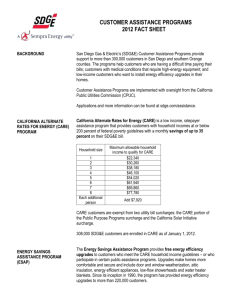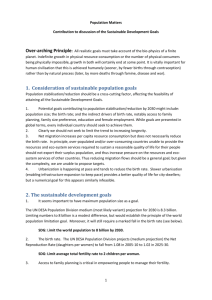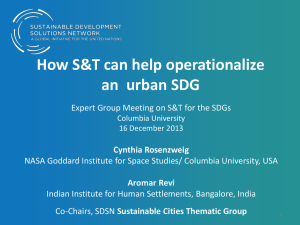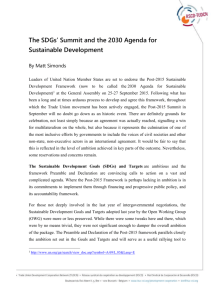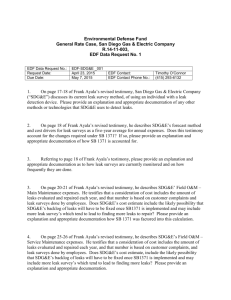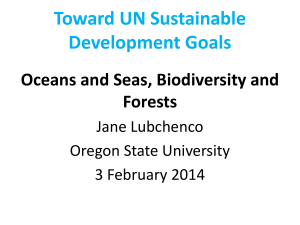SDG&E 2014 All Source RFO
advertisement
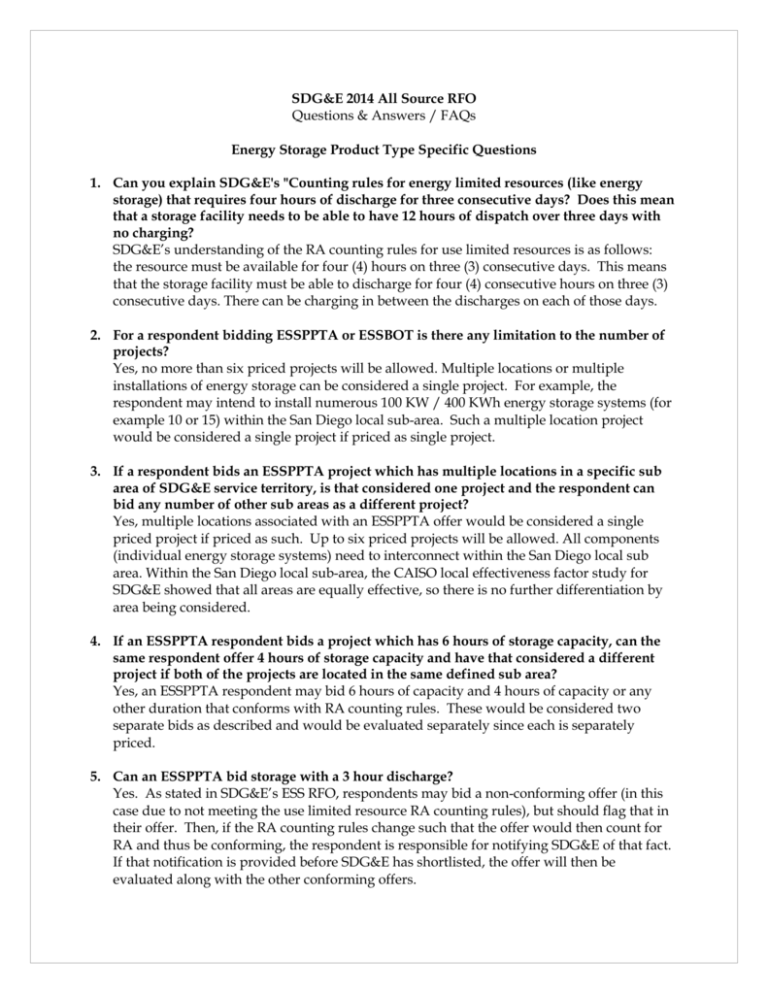
SDG&E 2014 All Source RFO Questions & Answers / FAQs Energy Storage Product Type Specific Questions 1. Can you explain SDG&E's "Counting rules for energy limited resources (like energy storage) that requires four hours of discharge for three consecutive days? Does this mean that a storage facility needs to be able to have 12 hours of dispatch over three days with no charging? SDG&E’s understanding of the RA counting rules for use limited resources is as follows: the resource must be available for four (4) hours on three (3) consecutive days. This means that the storage facility must be able to discharge for four (4) consecutive hours on three (3) consecutive days. There can be charging in between the discharges on each of those days. 2. For a respondent bidding ESSPPTA or ESSBOT is there any limitation to the number of projects? Yes, no more than six priced projects will be allowed. Multiple locations or multiple installations of energy storage can be considered a single project. For example, the respondent may intend to install numerous 100 KW / 400 KWh energy storage systems (for example 10 or 15) within the San Diego local sub-area. Such a multiple location project would be considered a single project if priced as single project. 3. If a respondent bids an ESSPPTA project which has multiple locations in a specific sub area of SDG&E service territory, is that considered one project and the respondent can bid any number of other sub areas as a different project? Yes, multiple locations associated with an ESSPPTA offer would be considered a single priced project if priced as such. Up to six priced projects will be allowed. All components (individual energy storage systems) need to interconnect within the San Diego local sub area. Within the San Diego local sub-area, the CAISO local effectiveness factor study for SDG&E showed that all areas are equally effective, so there is no further differentiation by area being considered. 4. If an ESSPPTA respondent bids a project which has 6 hours of storage capacity, can the same respondent offer 4 hours of storage capacity and have that considered a different project if both of the projects are located in the same defined sub area? Yes, an ESSPPTA respondent may bid 6 hours of capacity and 4 hours of capacity or any other duration that conforms with RA counting rules. These would be considered two separate bids as described and would be evaluated separately since each is separately priced. 5. Can an ESSPPTA bid storage with a 3 hour discharge? Yes. As stated in SDG&E’s ESS RFO, respondents may bid a non-conforming offer (in this case due to not meeting the use limited resource RA counting rules), but should flag that in their offer. Then, if the RA counting rules change such that the offer would then count for RA and thus be conforming, the respondent is responsible for notifying SDG&E of that fact. If that notification is provided before SDG&E has shortlisted, the offer will then be evaluated along with the other conforming offers. 6. Can an ESSPPTA bidder bid a single bid that includes Energy Storage, Demand Response, Energy Efficiency and would that be counted as one bid or as 1 ESSPTA bid, 1 Demand Response bid, 1 Energy Efficiency bid. Depending on the nature of the bid, it may be considered a single bid (and based on its nature, it would be categorized into one of the mentioned product types) and evaluated as a single offer, or it may be considered separate bids and evaluated separately – again, depending on the nature of the offer, including the pricing and operational intent). SDG&E would need to understand the specifics of this case in order to give a specific answer. 7. Will the Lake Hodges hydro project count towards the 25 MW of ES required under this All Source RFO? No, Lake Hodges is existing energy storage facility and would therefore not meet the incremental requirement. 8. How much of the minimum 25 MW for ES associated with this All Source RFO could come from UOG? SDG&E can own 100% of the 25 MW. 9. As it relates to the Energy Storage Decision (D.13-10-040), can SDG&E own 50% overall of the 165 MW ES target, or 50% of each domain? Yes, SDG&E can own 50% overall target. There is no ownership limitation by domain. 10. How does ES count against DR (if ES is used to reduce use)? SDG&E would evaluate the project as a DR resource, and would count the ES component towards its Energy Storage Decision (D.13-10-040) ES procurement target based on the interconnection point. 11. Is there a term rate for (round trip) ES efficiency? No minimum round trip efficiency will be required. 12. Will SDG&E specify the MWh duration that the ES system must run? The project must meet the RA counting rules (4 consecutive hours for 3 consecutive days) as a minimum requirement. 13. Is there a typical cycle requirement for ES? No, there is no minimum cycle requirement. However, SDG&E prefers systems with a capability for a minimum of 50 cycles per year. 14. Will there be additional information on ES cycling to account for degradation, or further information regarding full cycles? No, Respondents should provide this information in the offer form. In the Energy Storage offer form, SDG&E requests information on degradation of both capacity and system efficiency; it is up to the Respondent to accurately describe their system in this regard. Additionally in the ES offer form, limits on the number of deep and shallow discharges is requested (on a daily, weekly, monthly and annual basis as well as for the contract term or useful life). The Respondent defines deep and shallow discharges. 15. If a developer increases the capacity of an existing ES facility, would that count as incremental? SDG&E would have to review the bid specifics to determine if this would be incremental. Potentially the additional capacity could be incremental. 16. Is replacing a CCGT with ES considered incremental? Probably not as it would just be replacing existing capacity. SDG&E would need to understand the offer specifics (ie: how it was shown/counted in the ISO studies, whether or not it shifts load, and the structure of the offer) in order to answer authoritatively. 17. What is the ES installation deadline? This All Source RFO requires that the delivery term for the resource encompass all of calendar year 2022. This is sooner than the Energy Storage Decision deadline of year-end, 2024. 18. Can new ES come online as early as 2016? Yes. However, the contract term must encompass all of calendar year 2022, but SDG&E will accept bids from projects that would begin deliveries prior to 2022. 19. Are 16 MW of ES required to be on prior to 2016? No. In its Energy Storage application (A.14-02-006) SDG&E specifies a 16 MW solicitation goal for the 2014 storage procurement cycle (See table LK-8, p. LSK-15 in the testimony of Mr. Lee Krevat – available here: http://www.sdge.com/regulatoryfiling/10246/sdge%E2%80%99s-energy-storage-procurement-application ). 12 MW referred to there (Local and Flexible Capacity Requirements – Transmission and Distribution connected) are intended to be met with this All Source RFO. The remaining 4 MW (Distribution Reliability/Power Quality) will be procured via a separate RFO to be issued no later than December 1, 2014. 20. Will ES output prior to 2017 be modeled or just included as cash flows? SDG&E will model deliveries as described in the offer documents. As a practical matter, SDG&E believes it would be very difficult to get the application associated with the All Source RFO contracts approved by the CPUC in time to support deliveries beginning in 2016. 21. Does ES need to obtain a CAISO deliverability study prior to bidding? No, but SDG&E does require that the developer pursue and obtain such a deliverability study to ensure that the resource counts for RA. 22. How will SDG&E value energy to charge ES? SDG&E will value energy to charge ES based on the best forecast of such costs available at the time that it evaluates bids. 23. Will ES EPC and ES tolling agreements be treated the same in terms of modeling the resource? Yes, a net market value will be calculated for each. For utility owned assets, the cost stream will be largely based on the revenue requirement associated with the asset. For third party owned assets, contract costs will be utilized in the calculation. 24. What is the process for determining ES risk? Will cutting edge technology be considered? PU Code 2835 (and following sections) require that “commercially available technology” be utilized. SDG&E interprets this to mean technologically mature and widely available resources. This means that R&D projects or proof of concept projects/technologies will not meet this standard. 25. Is there a locational preference for ES? All systems must interconnect within the San Diego Local subarea as defined by the CAISO. For a ESSBOT or ESSPPA project, the developer will need to find the location, and for an ESSEPC project, SDG&E will provide siting. 26. Some people think ES reduces the need for interconnection upgrades, will that be considered in this process? These types of potential benefits will not be included in SDG&E’s evaluation methodology for this solicitation. 27. If there were multiple batteries behind a distribution feeder, would they go through the interconnection study process as a single amount of capacity? Yes, they will be combined and studied from the closest connected transmission substation. 28. Will the technical specifications specify ES size? There are minimum size restrictions for SDG&E’s ES RFO. For utility owned (ESSBOT or ESSEPC), it is 10MW; for third party owned (ESSPPA) it is 500 kW. 29. For Energy Storage, what information will developers have about the site and what type of equipment it can support? For ESSBOT or ESSPPA offers, the developer/respondent is responsible for finding/securing sites. For ESSEPC offers, on or before October 31, SDG&E will provide information on sites as follows: SDG&E sends out information on utility owned land including buildable area, environmental limitations (if any), interconnection capacity limitations (if known), expected permitting complexity. 30. Will there be a proforma for ESSEPC and ESSBOT projects? Due to the unique nature of various energy storage systems coupled with the complexities of commercial arrangements, there will not be a pro forma contract for ESSEPC or ESSBOT. SDG&E shall provide shortlisted entities with a term sheet or a contract as a starting point for negotiations. 31. Can a company that expresses interest (that is, provides a written expression of interest) by the 10/1 (ESSEPC) or 10/17 (ESSBOT) deadline later transfer the project to another company, or merge with another company? It depends. If the new entity is bound by the terms of the NDA (as applicable), then perhaps. SDG&E would need to see the specifics in order to respond in an absolute manner. 32. Who will the SDG&E site locations be made available to? Only those interested in the ESSEPC offer and who have entered into an NDA with SDG&E 33. Other than credit requirements are there any deposits or fees for providing an ESSEPC offer? No. SDG&E had been considering a bid deposit for this offer type but will not require any such bid deposit. The only fee involved with the RFO is the Shortlist Acceptance Fee, which is the greater of $100,000 or $2 per kW of project nameplate / aggregate program capacity and shall be required to be paid to SDG&E within ten (10) business days of notification by SDG&E that the offer has been shortlisted. 34. Please explain what O&M services should be included in the energy storage offer pricing? If the technology requires active operations personnel, SDG&E seeks those to be vendor supplied. SDG&E envisions many installations being automated so the storage responds to dispatch orders from SDG&E without the need for operations personnel. Similarly, SDG&E envisions requisite maintenance activities being provided by the vendor commensurate with the maintenance requirements needed to meet warranty and guarantees. 35. Unless we can supply this O&M services, what would happen to us for bidding? This applies only to ESSEPC bids. The EPC contractor could find another company to partner with for the bid or SDG&E would assess if it were able to provide the O&M services, but in any case SDG&E requires that the Respondent provide pricing for O&M throughout the useful life of the asset. 36. According to PPT presented 9/26 pre-bid meeting, on page 81, it says December 10: ESSEPC bidders NOT seeking life duration O&M contracts submit O&M costs to RFO Mailbox…Allows SDG&E to validate before bids due. Does this mean that we would propose the O&M cost? Yes. SDG&E sees the vendor/bidder as the most knowledgeable of the product offered and best suited to estimate life of facility O&M costs. SDG&E needs these submitted prior to the overall offer due date (January 5) so it can validate the forecast as this will be part of the overall cost of ownership forecast. 37. If that is the case, how can we calculate the O&M cost ? If the Respondent is unable to identify expected O&M costs independently or with the assistance of a partner, then the product is not likely commercially proven. If O&M costs cannot be reasonably estimated or are unknown, then SDG&E would likely not want the product. 38. Does Sempra require that the EPC contractor meet the specified criteria, or does Sempra require that the combined team meet the specified criteria? SDG&E requires the team lead that has been signatory to the previously submitted NDA meet the specified criteria. Please particularly see commercial viability items 5 & 6 which provide guidance to the specific criteria that must be met by bidders using third party technologies. EPC contractors would be considered “integrators” in this context. 39. Can ESSEPC bidders propose more than one technology for SDG&E to review? Yes 40. Does the expression of interest deadline apply to energy storage (battery) equipment suppliers also? We were under the impression that it applies for "respondents" meaning those submitting proposal to SDG&E, not companies that supply equipment to the respondents/developers. The expression of interest should come from and NDA will be with respondents. Neither have to do with equipment suppliers. Equipment suppliers should not submit anything. SDG&E will not be procuring equipment, the EPC or BOT bidders will do so. 41. If XYZ Company has a ¼ MW system versus a 1 MW system in place with a solid trialed BMS/EMS, have met other IOU short list criteria, and have up to 1.25 MW/day of mfg capacity, are we disqualified under the ESSBOT Commercial Viability Criteria? Yes 42. If XYZ Company has chosen to provide an ESSBOT, can we change to an ESSEPC or an ESSPPTA? Deadline for ESSEPC was 10/1/2014, so you would not be able to change to an ESSEPC (and commercial viability for ESSEPC is the same as ESSBOT). There is no linkage between being an ESSBOT and ESSPPTA. Further, there is no commercial viability screening for ESSPPTA. ESSPTA would require your bid submittal by January 5, 2015. 43. Regarding the utility owned storage options, does SDG&E require that the EPC contractor meet the specified criteria, or does SDG&E require that the combined team meet the specified criteria? One possible scenario is the combined team referenced could consist of EPC contractor, ESS Manufacturer, plant control provider, etc. This question is moot for ESSEPC as it has already been addressed with respondents. For ESSBOT, SDG&E will accept a joint venture amongst two parties. Those two parties must meet all commercial viability requirements. Bidders that elect to form a joint venture do not need to form a separate LLC or other company. Both bidders may execute the EPC contract as joint venturers, with joint and several liability between the two parties. 44. If we formed a joint venture between XYZ and ABC, to provide EPC services, do we meet the intent of items 5 and 6 of the viability criteria? SDG&E would accept a formal joint venture in such circumstances per the above. 45. As a potential respondent, we are advising SDG&E that we are not able to submit certain information on behalf of all of the battery vendors that we have requested quotes from. Please confirm that we can still submit an offer. The first step was to provide an expression of interest and then to complete / execute an NDA. Second, equipment only vendors (companies that are solely equipment suppliers) are not suitable to be respondents for utility owned storage offers unless they are part of a joint venture. If the equipment / battery supplier is not the lead “EPC” or in a joint -venture, it is the responsibility of the bidder (respondent) to include the equipment information in their package and not the equipment manufacturer. SDG&E will not accept information from equipment suppliers that simply want to sell equipment. SDG&E intends for the utility owned storage offers to be EPC or BOT offers. 46. Does customer-side energy storage bid in as DR help SDG&E meet its customer domain energy storage goals? Yes – qualifying energy storage equipment installed behind customer meters can count toward SDG&E’s customer domain energy storage goals that are included in D.13-10-040 and as further detailed in D.14-10-045 (decision approving the IOU’s energy storage applications). 47. What was the registration deadline of October 1st for? The 10/1/2014 deadline was for the Utility owned storage, EPC approach, to provide their expression of interest. A similar deadline of 10/17 has passed for providing an expression of interest for the Utility owned storage, BOT approach. 48. Regarding shorter duration resources that don’t meet the 3 day / 4 hour per day requirement. How will such resources be evaluated? If the shorter duration is acceptable, we could bid a lower price…. As stated in the RFO for ESSPPTA only, to the degree a storage resource does not meet the RA counting rules respondents are directed to complete and submit their offer and indicate that it is non-conforming but that you believe the RA Counting rules will change. If and when they do change, notify SDG&E via the RFO e-mail box (AllSourceRFO@SempraUtilities.com ) of the rule change and if that occurs prior to shortlisting, assuming the offer is conforming in all other regards, it will be evaluated alongside the other conforming offers. If you believe a shorter duration resource can be priced lower, provide such an offer (indicating that it is currently non-conforming) using one of the allowed six priced offers. For ESSEPC and ESSBOT (utility owned) bids, such technology will not be accepted. 49. How many days per year should the energy storage resource be able to dispatch? See the Energy Storage RFO document. SDG&E has expressed a preference for at least 50 times per year. As stated in the RFO: “SDG&E will not require a minimum amount of annual cycles. However, SDG&E will give priority to ESS capable of at least 50 cycles per year.” 50. For the ESSEPC option, how do we obtain approval to visit the sites? Most sites do not require an approval to visit by SDG&E. The site list/maps that will be provided will be clear on the properties as to which sites can be visited with or without approval. Those entities that met the deadline for the expression of interest, that have executed an NDA, and have passed commercial viability screening will be provided with this information. 51. With regard to the 2014 All Source RFO, I would like to know, for the project described here, which RFO contract type would be appropriate in which to submit the project into the RFO. Project Description: A 2 MW battery storage project combined with a 2 MW solar PV project. The solar project would be used to charge the batteries. Assuming the battery is not used to serve any pre-existing behind-the-meter customer load and the battery is dispatchable, the RFO contract type would be the storage agreement, which is a tolling contract. Solar output in excess of charging (and not used to serve load) may be purchased through the renewable PPA template. If the battery is not dispatchable, but is only used to firm up the delivery profile of the solar plant and remove the intermittency of the solar resource, SDG&E will provide any shortlisted bidder with an RPS PPA template for use with unit firm deliveries. 52. We have questions about the suitability of our potential energy storage offer related to the 2014 all source RFO. It includes distributed energy storage located near customer sites but connected to the grid from the line side of the customer meter. <Note: SDG&E assumes this means on the utility side of the meter, not on the customer side of the meter> Our intent is to pool or aggregate numerous small storage systems into a MW scale resource but individually each site/meter will be less than 10 kW. Questions: 1) Is this potential offer conforming? The minimum size for energy storage systems is 500kW at each installation. If the storage system is installed on the customer side of the meter, it may be smaller than 500kW but would then fall under the DR RFO. Please see the DR RFO document for conformance requirements and other details regarding utilizing energy storage as DR. 2) Our idea is to aggregate numerous, small storage systems and we therefore do not expect to have site control at all sites at the time of bidding. Can we get a waiver on the site control requirement? No. If the offer is a grid side energy storage resource, the site control requirements detailed in the energy storage RFO are still applicable (respondents must have site control at the time of bidding for the duration of the term proposed). 3) Will there be an opportunity to combine and enhance the resources of this offer with the value offer from the upcoming Reliability RFO? SDG&E understands that this proposal involves utilizing the ESS for both market operations and potentially other uses. SDG&E believes there will be an must offer obligation for use limited resources such as energy storage (see: http://www.caiso.com/informed/Pages/StakeholderProcesses/FlexibleResourceAde quacyCriteria-MustOfferObligations.aspx ) and therefore is not intending to utilize storage for dual usage such as that described here. 4) Would the inclusion of solar connected to the system and offered as a firm DG resource be more or less attractive than strictly storage? The attractiveness of an offer from a quantitative standpoint is related to its net market value. To the degree that the addition of the solar system improves the overall NMV of the offer, it would be more attractive. Whether or not this is the case will depend on the cost of adding solar and the additional energy and capacity benefits the solar system represents. SDG&E will also consider qualitative factors. See the Energy Storage RFO document for details. 5) What, if any, additional requirements must be satisfied to qualify these small scale resources with respect to interconnection and CAISO integration? Please see the energy storage RFO. As stated, the resource must meet all applicable RA counting rules. Again, assuming the energy storage system(s) is (are) on the utility side of the meter, this means CAISO interconnection studies for deliverability (must NOT be for energy only) and meeting the 3 day / 4 hours per day requirement.
